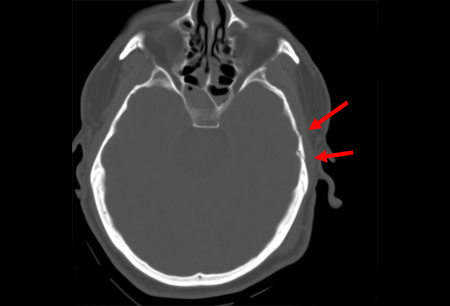Summary
Definition
History and exam
Key diagnostic factors
- risk factors
- open fracture
- palpable discrepancy in bone contour
- Battle's sign
- periorbital ecchymosis
- bloody otorrhoea
- cerebrospinal fluid rhinorrhoea
- facial paralysis, nystagmus, or paraesthesia
Other diagnostic factors
- evidence of trauma
- cranial pain or headache
- nausea/vomiting
- altered mental state/loss of consciousness
- abnormal pupillary reflexes
- hearing loss
Risk factors
- fall from height
- motor vehicle accident
- assault resulting in head trauma
- gunshots to the head
- male sex
Diagnostic investigations
1st investigations to order
- cranial CT
Investigations to consider
- skeletal survey
- MRI
- MR angiography
- beta-2 transferrin assay
- plain skull x-ray
- clotting screen
Treatment algorithm
suspected skull fracture (any type)
confirmed closed non-depressed fracture
confirmed closed depressed fracture
confirmed open fracture
persistent cranial nerve injury or CSF leakage
Contributors
Expert advisers
Kevin Tsang, MBBS, BSc (Hons), MRCS (Eng), FRCS (SN)
Consultant Neurosurgeon
Unit Training Lead and Clinical Teacher
Imperial College Healthcare NHS Trust
London
UK
Disclosures
KT declares that he has no competing interests.
Acknowledgements
BMJ Best Practice would like to gratefully acknowledge the previous expert contributors, whose work has been retained in parts of the content:
Demetrios Demetriades MD, PhD, FACS
Professor of Surgery
Director
Division of Trauma and Surgical Intensive Care
LAC+USC Trauma Center
Keck School of Medicine at USC
University of Southern California
Los Angeles
CA
Leslie Kobayashi MD, FACS
Associate Professor of Surgery
Division of Trauma, Surgical Critical Care and Burns
University of California San Diego
San Diego
CA
Disclosures
DD declares that he has no competing interests. LK declares that she has no competing interests.
Peer reviewers
Peter Whitfield, BM, PhD, FRCS Eng, FRCS (SN), FHEA, FAcadMEd
Professor of Neurosurgery
Consultant Neurosurgeon
University Hospitals Plymouth NHS Trust
Plymouth
UK
Disclosures
PW undertakes expert witness work, including in traumatic brain injury cases. He is also lead editor of the text book: Traumatic Brain Injury: a multidisciplinary approach. He receives royalties from Cambridge University Press.
Peer reviewer acknowledgements
BMJ Best Practice topics are updated on a rolling basis in line with developments in evidence and guidance. The peer reviewers listed here have reviewed the content at least once during the history of the topic.
Disclosures
Peer reviewer affiliations and disclosures pertain to the time of the review.
References
Key articles
National Institute for Health and Care Excellence. Head injury: assessment and early management. May 2023 [internet publication].Full text
Reference articles
A full list of sources referenced in this topic is available to users with access to all of BMJ Best Practice.

Differentials
- Intracranial haemorrhage
- Suture lines in children
- Cephalhaematoma
More DifferentialsGuidelines
- Head injury: assessment and early management
- Clinical practice guideline for paediatric head injury
More GuidelinesCalculators
Glasgow Coma Scale
More CalculatorsLog in or subscribe to access all of BMJ Best Practice
Use of this content is subject to our disclaimer